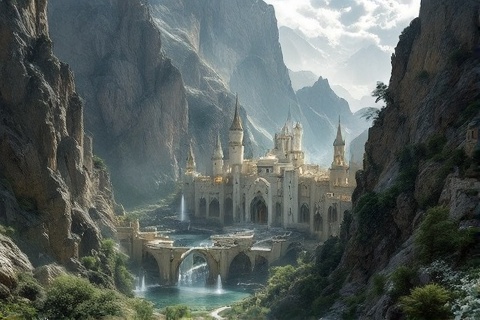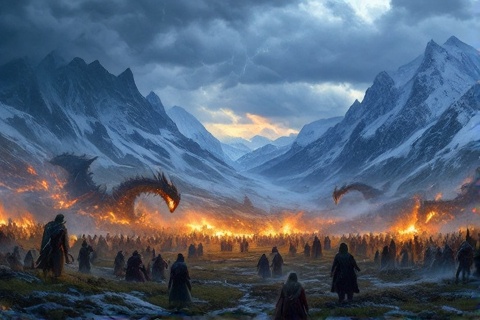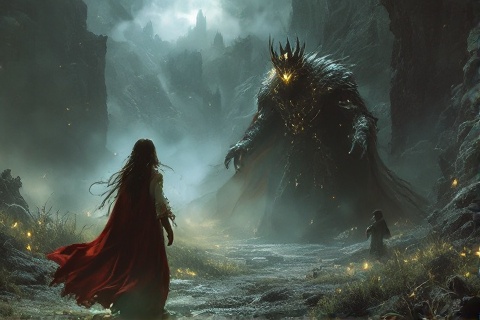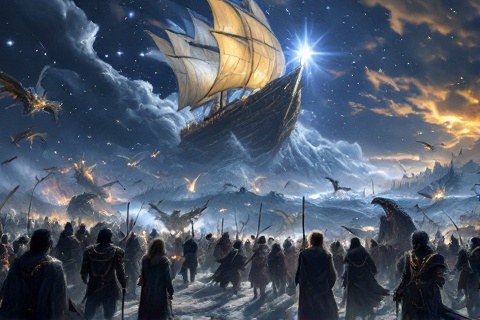
The First Age: When Legends Walked Middle-earth
Unveiling the Myths, Heroes, and Tragedies of Tolkien's Earliest Age
Dawn Before Days: The Two Trees and the Awakening of the Elves

In the beginning of the First Age, the world was illuminated by the radiant Two
Trees of Valinor, created by Yavanna after the destruction of
the Two Lamps. Telperion, the elder tree, gave forth a silvery light, while
Laurelin shone with golden radiance. Their intermingled light blessed Valinor
with unmatched beauty, marking the count of hours as they waxed and waned in
alternation. The Valar and Maiar lived in this
blessed light, and later the Elves would measure all subsequent
ages against the glory of the Time of the Trees.
At the waters of Cuiviénen, beneath the stars of Varda, the first Elves
awakened. These Firstborn of Ilúvatar opened their eyes to see the stars
reflected in the waters of the inland sea in the east of
Middle-earth. The Vala Oromë first discovered them during
his travels, finding them dwelling by the starlit mere, speaking their first
words and giving names to all they saw. This discovery would change the course
of history, as the Valar soon learned of Melkor's shadow
that haunted the Firstborn, taking some for his evil purposes.
Following Oromë's discovery, the Valar debated the fate of the Elves and decided
to summon them to Valinor for their protection and blessing. Thus began the
Great Journey westward, led by Oromë himself. The Elves divided into three main
groups: the Vanyar, the Noldor, and the
Teleri. While many heeded the summons and began the long march
west, some refused and became known as the Avari. The journey would shape the
destiny of the Elven peoples, establishing divisions that would persist
throughout the ages of Arda.
The Bliss of Valinor and the Forging of the Silmarils

Under the leadership of Fëanor, greatest of all craftsmen
among the Elves, the Noldor reached unprecedented heights of skill and knowledge
in Valinor. Son of Finwë and Míriel, Fëanor's brilliance led
to the creation of many wonders, including the Tengwar script and the
palantíri. His works transformed Noldorin society,
inspiring them to become masters of gemcraft, metallurgy, and linguistics. The
Noldor built great cities and towers in Valinor, their achievements surpassing
anything that would come after in Middle-earth.
Fëanor's greatest achievement was the creation of the
Silmarils, three perfect jewels that captured and
preserved the holy light of the Two Trees. These gems were hallowed by Varda
herself, so that no mortal flesh or evil hands could touch them without being
burned. Within these jewels, Fëanor locked not just light, but the very essence
of the Trees, a feat that could never be repeated. The Silmarils became objects
of overwhelming desire and reverence, admired by Valar and Elves alike.
Despite the seeming perfection of life in Valinor, Melkor's subtle influence
began to create discord among the Noldor. Released from his imprisonment and
feigning reformation, he spread whispers of the Valar's supposed jealousy and
manipulation of the Elves. Melkor particularly targeted Fëanor, playing upon his
pride and suggesting that the Valar would take his Silmarils. These poisonous
words found fertile ground in the hearts of many Noldor, who began to dream of
realms of their own in Middle-earth.
Darkness Falls: The Darkening of Valinor

In an act of ultimate malice, Melkor allied with
Ungoliant, a dark spirit in the form of a monstrous
spider, to destroy the Two Trees of Valinor. During a festival when the Valar
and Elves were gathered elsewhere, they struck. Ungoliant drained the Trees of
their light and life, injecting them with deadly venom. The world plunged into
darkness as Telperion and Laurelin withered, their light preserved only within
the Silmarils. This deed marked the end of the blessed realm's greatest glory
and the beginning of darker days.
While the Valar and Elves were in confusion following the Trees' destruction,
Melkor and Ungoliant attacked Formenos, the stronghold of
Fëanor. There they slew Finwë, High King of the Noldor, who alone had remained
behind to guard the Silmarils. Melkor, whom Fëanor afterward named Morgoth,
stole the jewels and fled to Middle-earth. The death of Finwë was the first
killing of an Elf by another being in Valinor, marking a tragic turning point in
the history of the Noldor.
In grief and rage over his father's murder and the theft of his greatest works,
Fëanor gathered the Noldor and swore a terrible oath. He and his seven sons
bound themselves to pursue with vengeance any who should withhold the Silmarils
from them. The Valar responded through Mandos, who pronounced the Doom of the
Noldor, warning that their quest would end in tragedy and that those who pursued
it would be banned from returning to Valinor. This prophecy would shadow all
their subsequent deeds in Middle-earth.
The Flight of the Noldor
The first terrible consequence of Fëanor's oath occurred at
Alqualondë, the harbor of the Teleri. When the Teleri
refused to give their ships to the Noldor for the journey to Middle-earth,
Fëanor ordered his followers to take them by force. This led to the First
Kinslaying, where Elf slew Elf for the first time in history. The white shores
of Alqualondë were stained red with the blood of the mariners, an act that would
forever haunt the Noldor and bring the curse of the Valar upon them.
Following the Kinslaying, Fëanor led the host of the Noldor northward toward the
Helcaraxë, the grinding ice that connected Aman to Middle-earth. The journey was
fraught with hardship and dissent, as many of the Noldor, especially those who
followed Fingolfin, began to question Fëanor's
leadership. The harsh conditions and the weight of their deed at Alqualondë
tested their resolve, yet they pressed on, driven by Fëanor's fierce
determination and their own pride.
At Losgar, Fëanor committed his most treacherous act against his own people.
After crossing the sea with his most loyal followers, he ordered the ships of
the Teleri to be burned, abandoning Fingolfin and his people to either return to
Valinor in shame or attempt the perilous crossing of the Helcaraxë. The flames
of the burning ships lit the night sky, a signal of betrayal visible to those
left behind. Many perished in the crossing of the grinding ice, adding another
dark chapter to the exodus of the Noldor.
Realms in Exile: The Noldor in Middle-earth

Upon reaching Middle-earth, the Noldor established powerful kingdoms throughout
Beleriand. Fëanor's sons claimed the eastern territories,
while Fingolfin became High King after Fëanor's death and established his realm
of Hithlum in the west. Other Noldorin lords, including
Finrod and Turgon, founded their own domains.
These kingdoms became centers of culture and learning, where the Noldor shared
their knowledge with the Sindar, the Grey-elves who had remained
in Middle-earth.
Two of the most remarkable hidden kingdoms were established during this time.
Turgon built the secret city of Gondolin, inspired by
Tirion upon Túna in Valinor, concealed within a ring of
mountains. Finrod, with the help of the Dwarves, carved out the
underground fortress of Nargothrond along the river Narog.
These realms became the greatest achievements of Noldorin architecture and
craftsmanship in Middle-earth, rivaling the splendor they had left behind in
Valinor.
For nearly four centuries, the Noldor maintained a precarious peace through the
Siege of Angband, containing Morgoth's forces within his
northern fortress. This period, known as the Long Peace, saw the Noldorin realms
reach their height of power and cultural achievement. The Elves formed alliances
with the Dwarves and the newly-awakened Men, teaching them many
skills and lore. However, this peace was deceptive, as Morgoth's strength grew
in secret, and his spies worked to undermine the unity of his enemies.
The Great Battles of Beleriand

The Long Peace ended catastrophically with the Dagor
Bragollach, when Morgoth broke the Siege of Angband
with rivers of flame and armies of Balrogs and dragons. His forces, led by
Glaurung the first of the fire-drakes, overwhelmed the
Noldorin defenses in the north. Many great lords fell in this battle, including
Fingolfin's son Fingon, and the carefully maintained network of fortresses and
watchtowers burned. The High King Fingolfin, in despair at the destruction of
his realm, rode alone to challenge Morgoth to single combat, wounding him seven
times before falling.
The Nirnaeth Arnoediad proved to be the most devastating battle of the First
Age, where the combined forces of Elves, Men, and Dwarves made their greatest
attempt to defeat Morgoth. Despite initial successes and the valor of heroes
like Húrin and Huor, the battle ended in complete disaster when the Men of
Ulfang betrayed the sons of Fëanor. The field was strewn with countless dead,
earning its name 'The Battle of Unnumbered Tears.' This defeat marked the
beginning of the end for the Noldorin realms in Beleriand.
Following the Nirnaeth Arnoediad, Morgoth's forces systematically destroyed the
remaining Elven kingdoms. Nargothrond fell to Glaurung the dragon, while the
hidden realm of Doriath was sacked twice, first by the Dwarves
and then by the sons of Fëanor, fulfilling their terrible oath. The Havens of
Sirion became a refuge for survivors, but even this last haven would eventually
fall to the sons of Fëanor in their relentless pursuit of the Silmaril.
Tales of Hope and Tragedy

The tale of Beren and Lúthien
stands as one of the greatest love stories of the First Age. Beren, a mortal
Man, fell in love with Lúthien, daughter of King Thingol and the Maia
Melian. When Thingol demanded a Silmaril as bride-price,
their quest led them into the very depths of Angband. Through Lúthien's power
and Beren's courage, they succeeded in taking a Silmaril from Morgoth's crown,
though Beren lost his hand to Carcharoth, the great wolf. Their story ended in
both triumph and sacrifice, as Lúthien chose mortality to follow Beren beyond
the circles of the world.
The tragic tale of Túrin Turambar exemplifies the
doom that fell upon both Elves and Men in the First Age. Son of Húrin, whom
Morgoth had cursed, Túrin's life was marked by pride, misfortune, and darkness.
He became a great warrior but unknowingly married his own sister Nienor, who had
been enchanted by Glaurung the dragon. Upon learning the truth, both took their
own lives, fulfilling Morgoth's curse upon their family. Their story remains one
of the most sorrowful in all of Tolkien's legendarium.
Gondolin's fall came through betrayal, when Maeglin,
Turgon's nephew, revealed the hidden city's location to Morgoth. The dark lord's
forces, led by Balrogs and dragons, breached the city's defenses during a
festival. Though the defenders fought valiantly, with Ecthelion slaying Gothmog,
lord of Balrogs, and Glorfindel sacrificing himself to
save the refugees, the great city was destroyed. Tuor led many survivors to
safety, including Idril and their young son
Eärendil, who would later play a crucial role
in Middle-earth's salvation.
The War of Wrath and the End of the First Age

Eärendil's voyage marked a turning point in the history of Arda. Son of Tuor and
Idril, he married Elwing, who possessed the Silmaril rescued by Beren and
Lúthien. Seeking aid from the Valar, Eärendil sailed westward in his ship
Vingilot, guided by the light of the Silmaril. Through great peril and with the
blessing of the Valar, he reached Valinor, becoming the first mortal to set foot
upon its shores. His plea for mercy for both Elves and Men moved the Valar to
action.
The Host of the Valar, led by Eönwë, Herald of Manwë, arrived in Middle-earth
with unprecedented might. This army included Vanyar Elves and those Noldor who
had remained in Valinor. The power of their coming broke the shores of
Middle-earth and shook the foundations of Angband. The War of
Wrath began, the greatest battle ever fought in Arda,
where the forces of the Valar confronted Morgoth's armies of Balrogs, dragons,
and countless other creatures of evil.
The final defeat of Morgoth came after decades of warfare that reshaped the
continent. The forces of the Valar overthrew Angband, and Morgoth was captured,
bound with the chain Angainor, and cast into the Void beyond the world. However,
the violence of the battle caused Beleriand to sink beneath the waves, forever
changing the shape of Middle-earth. The survivors of the First Age, both Elves
and Men, had to find new homes in the lands that remained.
The two remaining Silmarils met their destined end after Morgoth's defeat. The
sons of Fëanor, bound by their oath, stole them from the camp of the Valar.
However, the holy jewels burned their impure hands, causing Maedhros to cast
himself and one Silmaril into a fiery chasm, while Maglor threw his into the
sea. Thus, the Silmarils were dispersed into the elements of Arda: one in the
sky with Eärendil, one in the earth's fiery depths, and one in the ocean's
depths, fulfilling an ancient prophecy about their fate.
